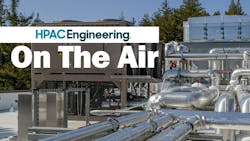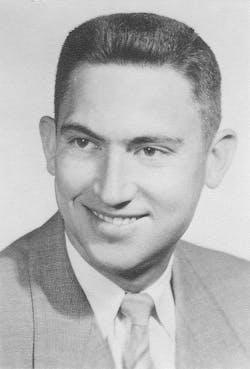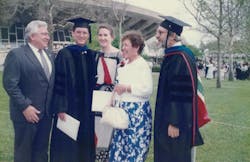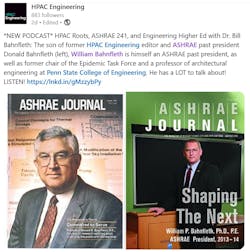HPAC History, ASHRAE 241, and Higher Ed with Bill Bahnfleth
This month, HPAC 'On The Air' welcomes back Dr. Bill Bahnfleth, ASHRAE past president, former chair of the ASHRAE Epidemic Task Force, and longtime professor of architectural engineering at Penn State University.
Coincidentally, Bill's father Donald Bahnfleth also served as editor of HPAC Engineering throughout the 1960s, and later became ASHRAE president, himself. That made them the first father & son pair to ever both serve atop the Society. So there is much to unpack in this wide-ranging and entertaining episode.
To listen to this month's episode, click below...
What follows is an edited transcript of this podcast...
HPAC: Bill, as we look back on the history of HPAC Engineering over the last century, it occurs to me that you have a unique perspective as the son of one of HPAC Engineering's more accomplished editors, Donald Bahnfleth. Do you have any recollections of his time at Heating, Piping and Air-Conditioning?
Bahnfleth: The time that he was at HPAC was from when I was about two or three years old until I was a freshman in high school. So I had no idea at that point that I'd be an engineer for a career. I was aware of a lot of it just in the way that you're aware of what your parents are doing. But I do have a lot of memories because my father was really into his career in a lot of ways... He would talk about work and he had a number of professional friends who we would have coffee with on the weekends. They would just talk for hours about technical things.
He actually started as an academic, as a research assistant professor at the University of Illinois where he was good friends with a colleague named Bob Roose who was the editor before him. And at some point, my father decided that he and my mother wanted to be closer to both sets of their parents in the suburbs of Chicago. And Bob said, "Well, why don't you come work with me?" So, that's how he got into the magazine.
He was one of those people who kind of worked to live and it was woven through the fabric of his life. What I got from him was that it was really important to be rigorous in what you did in engineering. I really saw the magazine in those days as being one of the main places that solid technical information could be published. You look back at the articles that were written back then, there weren't a lot of competitors and it was really high quality, and I still refer to some of the things from those days.
When my father decided to move on, to be honest, it was really because he was afraid the magazine was going to move. He liked his job well enough, but it was bought and sold a few times back then, and it looked like I might be going to Connecticut. That was when he left and went to Cincinnati and became a consulting engineer.
And it turned out that even with all the years in publishing, that he was extremely good at that and made the transition and was a well-known practitioner for the rest of his career. I could say what he contributed to HPAC was kind of a lasting legacy. He really raised the level of the content and created a magazine that professionals could trust.
HPAC: Of course, you two are also the only father-son pair in ASHRAE history to both serve separately as Society president. Talk a bit about that, if you would. How did your father help mentor you in the engineering profession? How did he feel when you followed in his path as president some three decades later?
Bahnfleth: Well, he could not have been happier that I wound up becoming the first son of a former ASHRAE president to become president, myself (in 2013-14). How did he mentor me? The way a lot of good mentors do, mostly just by being a good example. There's a lot to be said for simply being a good role model. And as with his role at the magazine and his role at the company that he came to lead eventually, ZBA in Cincinnati, he always had high standards.
It was another one of those things that really went on seven days a week, 12 months of the year. So I heard a lot of discussions about what was going on in ASHRAE as I was going up, got a sense of the politics, a sense of the issues that they were involved in, and I started 30 years later to get into technical committees and those sorts of things and to move up.
I think the benefit that I got from all of that was that I was already primed on what it was like to be in leadership of a technical society, and my father was there in some pretty interesting times.
I think what happened during his time on the board and when he was a senior technical leader in ASHRAE were things like the oil embargo slash energy crisis that happened in the 1970s. So he was involved in the not-so-successful but important emergency building temperature regulations that were issued during the Carter Administration. He was around but not directly involved in the development of the first ASHRAE Standard 90. And he was there when "sick building syndrome" became a big issue, partly because of the energy crisis.
It wasn't until much later that I learned that he was probably as much of an advocate for indoor air quality in his way as I am today. I didn't discover that until I got asked to do a keynote for an ASHRA IEQ conference. There, I learned that he had been a central figure in getting the Environmental Health Committee of ASHRAE started and promoting better air quality. You can go back and find that in his (1985-86) presidential address. To the extent that the environmental health committee a few years ago renamed its Environmental Health Award after my father. I was very honored to be the first recipient of that renamed award.
So it's kind of amazing the scope of what he did in his career, both as a practitioner and as a leader in ASHRAE. (Don passed in 2016 at the age of 89.)
HPAC: Your day job, of course, is focused on the next generation as a professor of architectural engineering at Penn State, where you have been teaching since 1994. Since the fall semester is now underway, can you speak for a moment about the current state of engineering programs in higher ed. What sort of trends are you seeing with students and recent graduates? As an educator, how does it all make you feel about the next generation and the state of our industry?
Bahnfleth: Well, we always get bright students here, and I think my experience over 30 years is that they've always been welcomed by industry and are doing a good job and growing in their careers. [But] higher education, at least in the U.S., is really going through a period of crisis and readjustment. Part of that's due to the Baby Boom ending and just sort of the natural fall in enrollments which is making it hard to cover costs.
And so Penn State and others are struggling to make ends meet right now. I'm sure they'll come out of it, but it's still a little bit of a tough time when you look at engineering from the point of view of the construction industry, and HVAC specifically, which I'm involved in. I think over several decades we've seen a lot of mechanical engineering programs pretty much divest themselves of HVAC as being kind of low-tech: Not quite trades from their point of view, but not really the sexy materials and rocket science kind of stuff that they like.
My department at Illinois used to be mechanical and industrial engineering, and now it's mechanical science and engineering, and they've merged with theoretical and applied mechanics. So they still do some things that are related, but turning out actual practitioners, I think, has been left to other kinds of programs.
Architectural engineering is certainly the bright spot in engineering education in the U.S., not just Penn State. A lot of other schools that have been around for a long time like Kansas and Kansas State and some of the newer ones like Nebraska, are doing really well in that area. So I think that's promising. But there isn't enough capacity and that's reflected in the current ASHRAE president Dennis Knight's focus this year on "workforce development." I think that's an important theme to have right now. It's really kind of top to bottom.
We are short on the engineers that we need in the business. But because there's been so much emphasis on four-year college degrees as the only way to a successful life, we are also really short on skilled tradespeople.
You go to Denmark where I was on sabbatical, and they're not tradespeople. They're craftsmen and it's appropriate. They get better pay and it's a totally respectable kind of career where they have a system for producing those people. So we're having kind of an infrastructure problem (within our industry).
HPAC: Nowadays, workplace shortage conversations almost always end up involving discussions of how technology can fill the gap. How are those types of issues being addressed in engineering schools now?
Bahnfleth: Information technology is changing the way that we look at education. I'm an engineer educated in the 1970s and '80s, and I still believe in fundamentals and the basic physical sciences and mathematics and all of that, But we've now got so much software that in practice you have to be able to use. So there's a lot of pressure to produce students who not only know the fundamentals but are basically competent in a lot of software tools.
And now A.I. is coming along creating both headaches and opportunities. It seems that in industry, they'll be using it to help them do their jobs faster, which is going to make them more productive. But within the academy, A.I. is creating real problems in terms of developing the skills you want students to have instead of having them shortcut to ChatGPT or some other tools. So yes, those are some of the things that are going on. There's always challenges, but I think there's always hope because the students who come in are really enthusiastic and motivated.
ASHRAE's board approved the project in December of 2022, and it took me until about February, about the time of the ASHRAE winter meeting to get a roster approved. And we started working at the end of February on it, and we delivered a final draft of the standard that was approved at the ASHRAE annual meeting that year in June.
So we've been doing that extensive efforts to talk about it, to publicize it to all kinds of audiences, not just to ASHRAE chapter meetings and conferences. I've spoken around the world on 241. In fact, I got my second case of COVID while I was in Madrid at an IAQ Conference, giving a talk about it.
So yeah, we're doing a good job of getting the word out on it, and we certainly see that there's a lot of interest in it. The heavy lift right now, and I think it's going to be successful, is to get formal adoption in state or local or federal law. And there's a huge effort going on there right now to understand where the opportunities are and to gather the stakeholders who are interested in supporting that kind of work and then to take the right actions to make things happen.
So glimmers of hope there, but it takes a long time to go from a new standard to adopted regulations.
####
To listen to previous 'HPAC On The Air' podcasts, visit our Members Only page.



